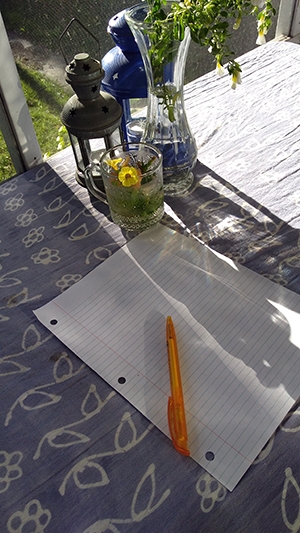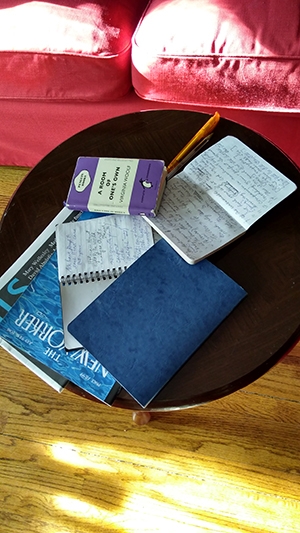Writing Spaces: Catherine Austen
This week in Writing Spaces, we take a look at the working space of Catherine Austen, author of “On Sulphur Mountain” in Issue #147.

I’ve had my own office at home for a few years now, since my oldest son moved out. The room is small and cosy, with the best lighting in the house. Half the room is for my writing, and half for my sewing. (I make quilts—some patchwork, some art.) It has all I need: a small desktop and computer, files to one side, and a to-do list on the table.
I have a stack of journals-in-waiting. (I splurge on Peter Pauper Press—they have the loveliest paper.) I journal every morning, and I read and take notes most evenings, but I do those things on the porch, at the kitchen table, at the cabin on the dock, pretty much anywhere but in my office. Journals and notebooks are where I play with ideas, ponder problems, plan scenes, and figure out where things need to go.

My office is where I turn ideas and notes into finished pages. It’s where I do the grunt work of drafting, revising, editing, to meet each day’s writing goals. (Today’s to-do list: edit one section of a youth writing anthology; expand a chapter outline into a scene-by-scene treatment; transcribe a chunk of research notes; write this blurb for TNQ.)
My workspace is reflective of my writing process because it offers a step away from writing. I can literally turn my back on a report or a novel and play with fabric.

Quilting is a good metaphor for writing a book. I often quilt by hand while watching TV. Sewing by hand for an hour results in very little progress. If you didn’t know any better, you might think it isn’t worth the bother, it’ll never amount to anything, there’s no way you could finish a whole quilt at this pace. But if you put in that hour a few times a week, week after week, you will eventually have a gorgeous quilt. It’s inevitable. (Well, the “gorgeous” part isn’t inevitable, but “finished” is.)

Writing can be the same, especially if I’m revising a messy draft. I try to focus on today’s bit of work without getting overwhelmed by how much more awaits. Sometimes the trick is to make today’s goal so tiny that there’s no excuse to avoid it. “Revise chapter 4” might be too ambitious. I could put that off for weeks. But “Print chapter 4” is something I can do right now, and “Reread chapter 4” is something I could easily do this morning, and “Make editorial notes on chapter 4, scene 1” is doable this afternoon. And maybe that’s enough for the day. I can then put the work away with the intention of coming back to it tomorrow to make notes on scene 2. Eventually, inevitably, the revision will get done. (But again, the “gorgeous” bit isn’t inevitable. Alas.)
I keep an extra chair in my office for guests.

We’re giving you a behind-the-scenes look into the writing process – straight from the desks (and decks, docks, beds, and favourite hiking trails) of our contributors! Check out the full series here.



